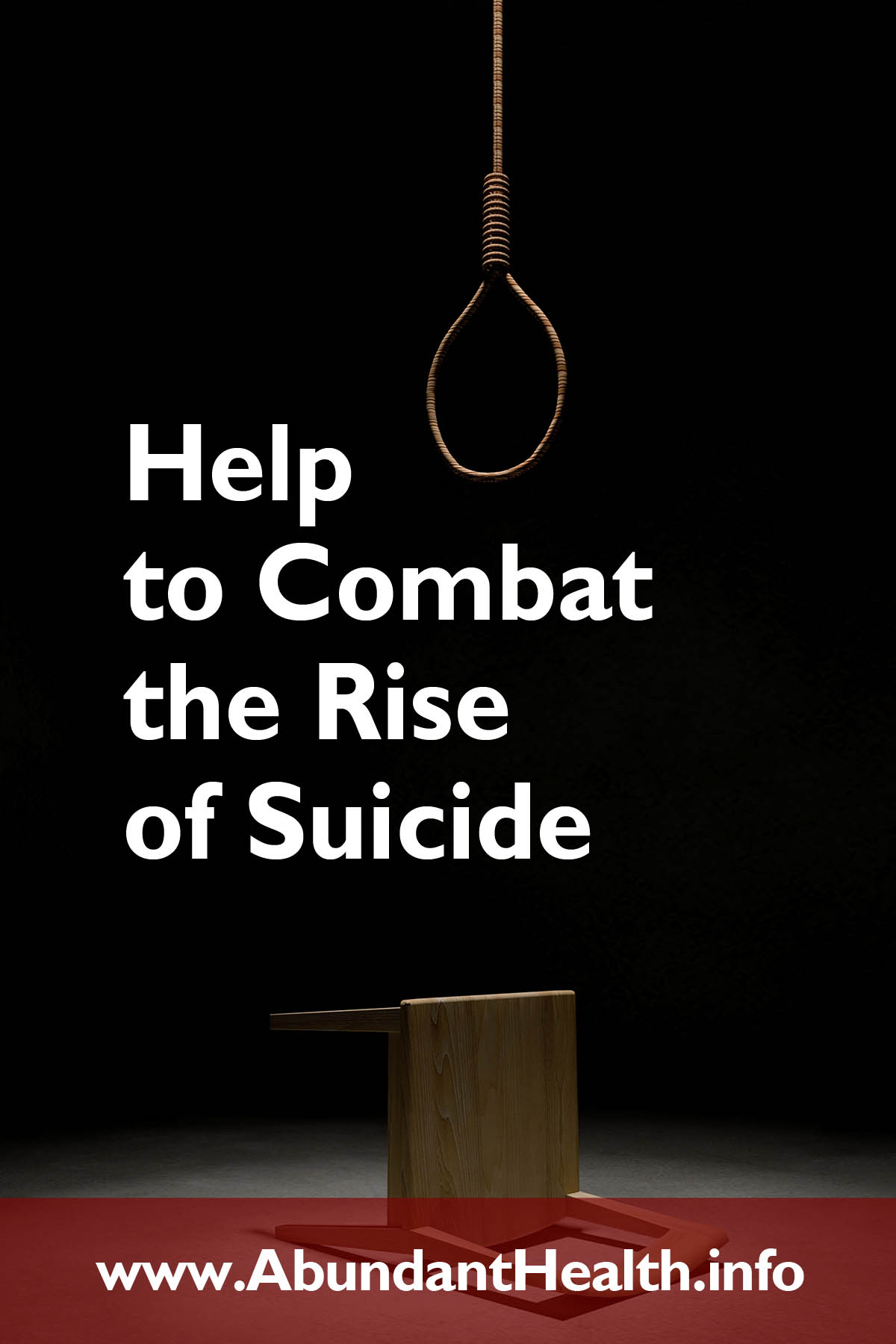Today I want to give you some information about a difficult, sad and tragic subject, but one that we need to talk about in order to advise you. It’s suicide. The incidence of suicide has increased. The act of killing oneself has to do mainly with depression, but also with other types of mental distress. The incidence of depression has grown worldwide. Unfortunately, from 2005 to 2015, the presence of this mood disorder, depression, increased by 18.4%. 350 million people of all ages suffer from depression, and around 800,000 people die by suicide each year, with suicide being the second leading cause of death during the second and third decades of life.

And do you know in which age group these deaths occur? People aged between 15 and 29. In the Americas, around 50 million people lived with depression in 2015, or around 5% of the population, according to a report by the World Health Organization and its partners. More than 3,000 adolescents die every day, totaling 1.2 million deaths a year from preventable causes. In 2015, more than two-thirds of these deaths occurred in low- and middle-income countries, Africa and Southeast Asia. Road traffic injuries, lower respiratory infections and suicides are the biggest causes of death among adolescents.
Suicide is the leading cause of death among Japanese men aged between 20 and 40. Japan’s rate of 18.5 suicides per 100,000 inhabitants is, for example, three times what is found in the United Kingdom, at 6.2, and the rate in the United States is about double, at 12.11. According to researchers, this happens mainly to the elderly population in Japan, mainly due to isolation, loneliness and serious financial problems, and those who can’t find a way out end up committing suicide. Young people in Japan also face hopelessness. In fact, loss of hope is at the core of depressive thinking, which is a strong predictor of suicidal ideation or even a suicide attempt.
Young Japanese people find it very difficult to ask for help. In addition to hopelessness, they face insecurity and a lack of stability in their jobs, which are normally short-term. Around 40% of young people can’t find stable jobs. So you can imagine the anguish they go through, having to pay bills and look after their family knowing that they have no job security. This really creates anguish and hopelessness and can lead them, among other things, to commit suicide at a young age.
One behavior that aggravates the tendency in young Japanese is the culture of not complaining and trying to resist alone. That’s how Japanese people are, hardcore. A large proportion of these young people isolate themselves, living mostly in the virtual world. And the culture is not conducive to expressing feelings. That’s interesting! We know that one of the factors of mental health has to do with a person’s ability to experience a feeling, an affection, and to express that affection. And experiencing means living that emotion, whether it’s pain, joy, guilt, happiness or sadness, without running away from that feeling. You express it, you talk about it, you verbalize it and you feel it. But in Japanese culture, this is more restricted. Not many feelings are expressed, and this can worsen people’s mental health.
In Japan, young people often take on responsibilities at an early age, such as looking after their siblings or having to work early to help with household expenses, and may be forced to drop out of school in order to generate an income. Sometimes they marry early or engage in transactional sex to meet their basic survival needs. As a result, they suffer from malnutrition, unintentional injuries, unwanted pregnancies, sexual violence, sexually transmitted infections and mental health problems.

A sociologist, Julio Jacobo, coordinator of violence studies at the Latin American Faculty of Social Sciences, comments that suicides are often invisible because they are a taboo that we keep quiet about. Homicides are an epidemic, but suicides also deserve attention, as they alert us to the immense suffering that leads young people to take their own lives.
Carlos Estelita, a child and adolescent psychiatrist and researcher at the Oswaldo Cruz Foundation, has studied the relationship between suicide and other forms of violence, such as social violence in communities where there is daily tension between bandits and the police, with death threats due to exchanges of gunfire and stray bullets. This researcher also cites bullying in schools as a contributing factor to suicide among young people.
If you have a teenage son or daughter who is starting to show significant changes in behavior, such as isolating himself or herself, staying locked in his or her room when before he or she was communicative, if the young person used to be calm and now becomes aggressive, if he or she starts sleeping more than usual or has insomnia, if there is acute rebelliousness or deep sadness with discouragement and a significant drop in school performance, and if he or she also distances himself or herself from friends, parents need to talk to this son or daughter and see what is going on. Depending on the level of change in behavior, it is important to take the young person for a professional assessment with a psychologist specializing in adolescence.
If you have been having persistent suicidal thoughts, or are planning suicide, call the Suicide & Crisis Lifeline 988, from anywhere in the US. You will receive professional assistance for free. For people who have attempted suicide or are at high risk, it’s a fundamental strategy. When a person attempts suicide, they need help quickly to prevent them from completing it.
These people who have already attempted suicide have at least a hundred times higher risk to repeat than the risk present in the general population. There is no single cause of suicide. It involves sociocultural, genetic, psychodynamic, philosophical, existential and environmental factors.
The existence of a mental illness is an important risk factor for suicide. A review of 31 scientific articles published between 1959 and 2001, covering 15,629 suicides in the general population, showed that in more than 90% of cases a diagnosis of mental disorder would have been appropriate at the time of the fatal act.
In this study of 15,629 suicide cases, it was found that 3.2% had no diagnosis, 10.6% had a diagnosis of schizophrenia, 11.6% had a personality disorder, 22.4% had substance use disorders (addiction to alcohol or other psychoactive drugs), and 35.8% had a mood disorder, such as depression or bipolar disorder.
The situation is exacerbated when there are combinations of illnesses, such as depression together with anxiety and agitation. But this doesn’t mean that every suicide is related to a mental illness, nor that everyone who suffers from a mental illness will commit suicide. But it is important to consider that the presence of mental illness is a risk factor for suicide.
The cause of suicide is very complex. There are predisposing factors that involve more than just one event. Depression is not necessarily caused by something recent, such as a job layoff or the end of a relationship. Sometimes a person experiences such a situation and becomes depressed, but it may be that this event is just the trigger, the last straw in the person’s life. Social conditions alone do not explain suicide either. People who take their own lives and who are experiencing difficult social conditions probably have an underlying mental disorder, which increases their vulnerability to suicide.
Deep down, the suicidal person doesn’t want to die; they simply don’t know how to go on living with what they see as a dead end. However, there is always a way out, not necessarily for what the person wants, but at least for them to learn to bear the loss, frustration and anger at reality, anger that is often directed against themselves, leading to self-harm.
Around 1 million people commit suicide every year in the world, which is equivalent to almost 2,740 a day, 14 an hour or almost two every minute. Considering attempts, the rate is much higher, reaching between 15 and 25 million a year globally. Even in developed countries such as South Korea and Japan, suicide rates are high, influenced by a number of factors, including competitiveness, mental pressure, economic difficulties, and family problems, among others.

A number of factors can lead a person to suicide, such as drug use, psychotic crises, financial failure, the end of a relationship, loss of a job, the death of a loved one, among others. Generally, those who commit suicide show signs that they are seriously thinking about it. An important help for a person who is potentially suicidal is the support of the family, valuing the person and their presence, as well as observing and taking serious typical phrases that indicate suicidal ideas.
It is important to approach the person who is facing suicidal thoughts, trying to understand what they are going through and encouraging them to seek psychiatric and psychological help. Showing the person how important they are in the lives of their children or grandchildren can be a significant incentive. Explaining that the human mind adapts to loss and that suffering is not eternal can also be comforting, showing that bad things also pass.
Then tell the person that, during an intense crisis of suicidal thoughts, when they find themselves bombarded by the idea of killing themselves, it is important that they share this with someone close to them. If they are alone, they should call a friend or relative and talk about it. If possible, leave the house and find a friend or family member who can offer support in an emergency. It is also crucial to get in touch with the professional who is treating you, to report what is happening and receive immediate help. Praying to control and dispel pessimistic thoughts is beneficial, as is holding on to your religious faith. It is essential to remind yourself that the bad feelings and destructive thoughts will not be constant, as long as you take steps to overcome them.
The family member or friend of someone who is suicidal need not be afraid to approach the subject, as this will not encourage the act. Open dialogue, with sincerity and a desire to help, can offer the person other perspectives and give them time to reconsider such a radical decision. This helps to overcome the difficult moment of negative mental pressure linked to the idea of death and prevents relapses into hopelessness. It is important to help the person reflect on their achievements and remind them of what God has done in their life, cultivating gratitude.
To prevent suicide, it is crucial that people develop strong emotional bonds throughout their lives, so that these friendships can be a crucial support. In addition, it is necessary to find a meaning in life that promotes hope, as hopelessness is at the heart of depressive and suicidal thinking. Practicing intimacy with God through prayer and the study of spiritual texts, such as the Bible, is fundamental to strengthening these emotional bonds and preventing suicide.
It is important to recognize that the climate of competition and the consumer lifestyle can contribute to feelings of hopelessness. Interviews with people who have attempted suicide show that many regret it, which highlights the importance of seeking help and finding alternatives. As it says in Isaiah 57:15: For thus says the High and Lofty One, who inhabits eternity, whose name is Holy: “I dwell in the high and holy place, with him who has a contrite and humble spirit, to revive the spirit of the humble, and to revive the heart of the contrite ones.”

Stay Always Up to Date
Sign up to our newsletter and stay always informed with news and tips around your health.

Dr. Cesar Vasconcellos de Souza is working as a psychiatrist and international speaker. He is author of 3 books, columnist of the health magazine “Vida e Saúde” for 25 years, and has a regular program on the “Novo Tempo” TV channel.
Leave a Reply